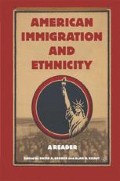Abstract
Throughout the nation’s history, one of the main reasons that Americans have been receptive to immigration has been the need for labor. During the colonial era, indentured servants and black slaves from Africa, involuntary migrants, supplemented the labor that European settlers poured into farms and plantations they hoped would yield sustenance for families and, eventually, commodities for commerce. In the early decades of the nineteenth century, many northern states abolished slavery as a labor system. Northern farmers found slave labor too costly and impractical for the small plot agriculture common in that region. The need for labor in the growing commercial and industrial sectors was satisfied by migrants from northern and western Europe and some free blacks. Much of the South continued to rely on black slave labor on its farms and plantations where large gangs of laborers made cotton production increasingly profitable. There, slavery persisted until the slaves were emancipated by the thirteenth amendment to the Constitution after the Civil War.
Access this chapter
Tax calculation will be finalised at checkout
Purchases are for personal use only
Preview
Unable to display preview. Download preview PDF.
Suggestions for Further Reading
David Emmons, The Butte Irish: Class and Ethnicity in an American Mining Town, 1875–1925 (Urbana IL: University of Illinois Press, 1989).
John Bodnar, The Transplanted, A History of Immigrants in Urban America (Bloomington, IN: Indiana University Press, 1985).
Lizabeth Cohen, Making a New Deal, Industrial Workers in Chicago, 1919–1939 (New York: Cambridge University Press, 1990).
Miriam Cohen, Workshop to Ofice, Two Generations of Italian Women in New York City, 1900–1950 (Ithaca, NY: Cornell University Press, 1992).
Sucheng Chan, The Bitter-Sweet Soil, The Chinese in California Agriculture, 1860–1910 (Berkeley, CA: University of California Press, 1986).
Susan Glenn, Daughters of the Shtetl, Life and Labor in the Immigrant Generation (Ithaca, NY: Cornell University Press, 1990).
Vicki Ruiz, Cannery Women, Cannery Lives: Mexican Women, Unionization and the California Food Processing Industry (Albuquerque, NM: University of New Mexico Press, 1987).
Copyright information
© 2005 David A. Gerber and Alan M. Kraut
About this chapter
Cite this chapter
Gerber, D.A., Kraut, A.M. (2005). What the Immigrants Make, America Takes: Work in Immigrant Communities. In: American Immigration and Ethnicity. Palgrave Macmillan, New York. https://doi.org/10.1007/978-1-137-08615-0_10
Download citation
DOI: https://doi.org/10.1007/978-1-137-08615-0_10
Publisher Name: Palgrave Macmillan, New York
Print ISBN: 978-0-312-29350-5
Online ISBN: 978-1-137-08615-0
eBook Packages: Palgrave History CollectionHistory (R0)

